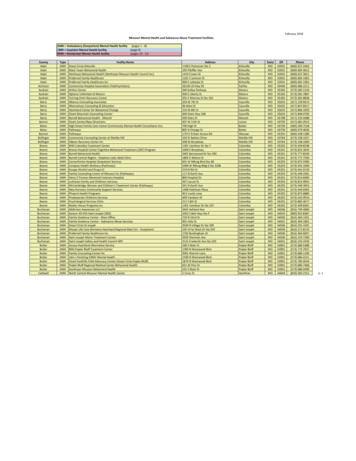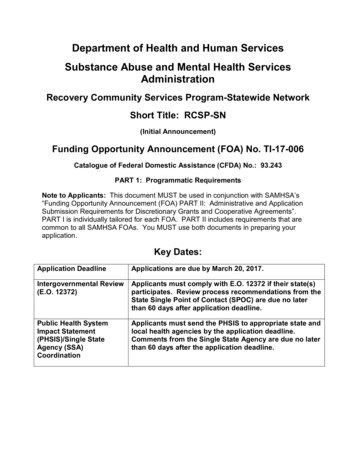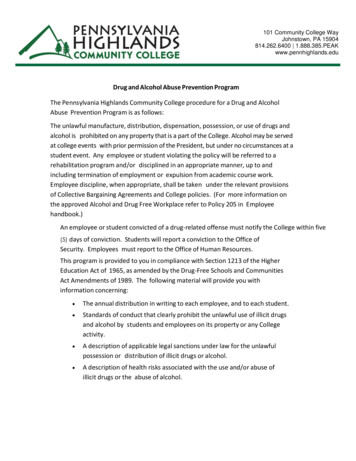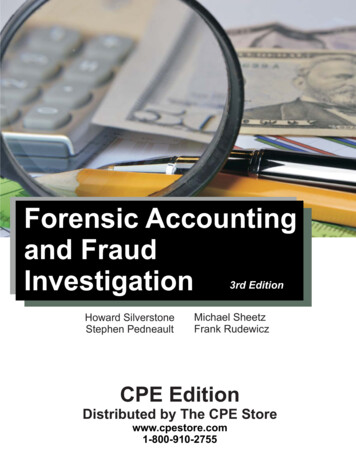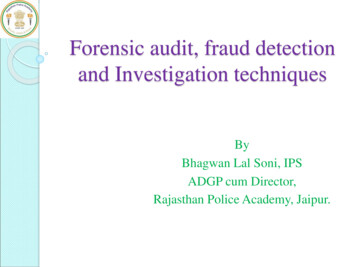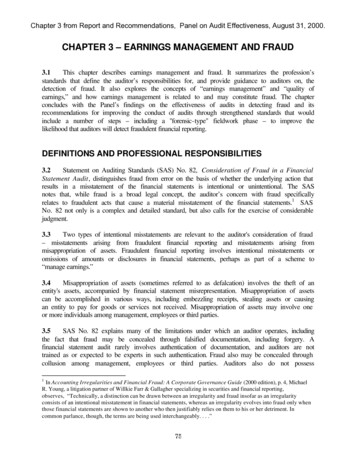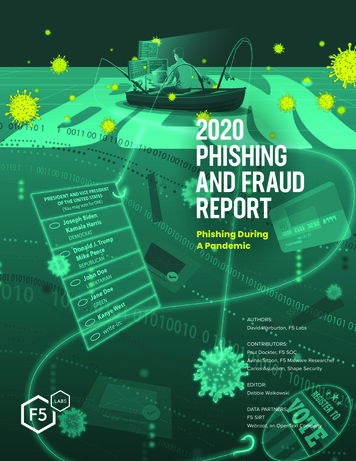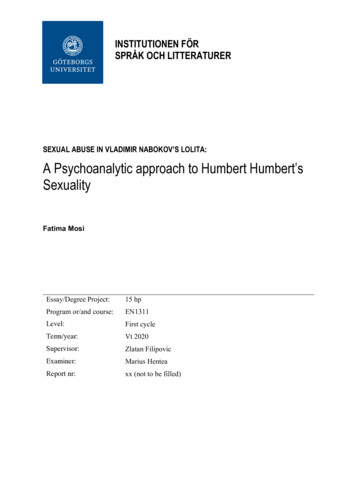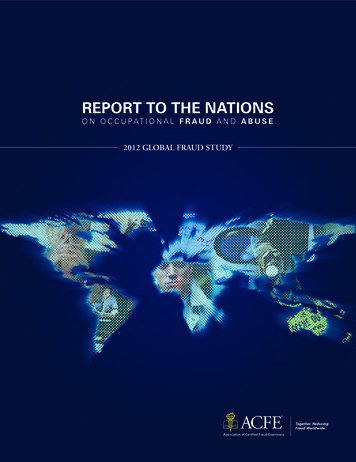
Transcription
REPORT TO THE NATIONSO N O C C U PAT I O N A L F R A U D A N D A B U S E2012 GLOBAL FRAUD STUDY
Letter from the President & CEOMore than 15 years ago, the ACFE’s founder and Chairman, Dr. Joseph T. Wells,CFE, CPA, conceptualized a groundbreaking research project to study the costs,methodologies and perpetrators of fraud within organizations. The result was the1996 publication of the ACFE’s first Report to the Nation on Occupational Fraudand Abuse. Since then, we have released six additional Reports that have eachexpanded our knowledge and understanding of the tremendous financial impactoccupational fraud and abuse has on businesses and organizations. We are proudto say that the information contained in the original Report and its successorshas become the most authoritative and widely quoted body of research onoccupational fraud.The data presented in our 2012 Report is based on 1,388 cases of occupational fraud that were reported by theCertified Fraud Examiners (CFEs) who investigated them. These offenses occurred in nearly 100 countries onsix continents, offering readers a view into the global nature of occupational fraud. As in previous years, what isperhaps most striking about the data we gathered is how consistent the patterns of fraud are around the globeand over time. We believe this consistency reaffirms the value of our research efforts and the reliability of ourfindings as truly representative of the characteristics of occupational fraudsters and their schemes.On behalf of the ACFE, and in honor of its founder, Dr. Wells, I am pleased to present the 2012 Report to theNations on Occupational Fraud and Abuse. It is my hope that practitioners, business and government organizations, academics, the media and the general public throughout the world will find the information contained inthis Report of value in their efforts to prevent, detect or simply understand the global economic impact ofoccupational fraud. 2012 REPORT TO THE NATIONS ON OCCUPATIONAL FRAUD AND ABUSEJames D. Ratley, CFE2President and CEOAssociation of Certified Fraud Examiners
Table of ContentsExecutive Summary. 4Introduction. 6The Cost of Occupational Fraud. 8 Distribution of LossesHow Occupational Fraud Is Committed. 10 Asset Misappropriation Sub-Schemes Duration of Fraud SchemesDetection of Fraud Schemes. 14 Initial Detection of Occupational Frauds Median Loss by Detection Method Source of Tips Impact of Hotlines Detection Method by Organization Size Detection Method by Scheme Type Detection Method by RegionVictim Organizations. 20 Geographical Location of Organizations Types of Organizations Size of Organizations Methods of Fraud in Small Businesses Industry of Organizations Anti-Fraud Controls at Victim Organizations Effectiveness of Controls Importance of Controls in Detecting or Limiting Fraud Control Weaknesses that Contributed to FraudCase Results. 61 Criminal Prosecutions Civil Suits Recovery of LossesMethodology. 64Appendix: Breakdown of Geographic Regions by Country. 67Fraud Prevention Checklist. 69Index. 70About the ACFE. 742012 Report to the Nations on Occupational Fraud and Abuse Perpetrators. 39 Perpetrator’s Position The Impact of Collusion Perpetrator’s Gender Perpetrator’s Age Perpetrator’s Tenure Perpetrator’s Education Level Perpetrator’s Department Perpetrator’s Criminal and Employment History Behavioral Red Flags Displayed by Perpetrators3
Executive SummarySummary of Findings Survey participants estimated that the typicalorganization loses 5% of its revenues to fraudeach year. Applied to the 2011 Gross WorldProduct, this figure translates to a potential projected annual fraud loss of more than 3.5 trillion. The median loss caused by the occupationalfraud cases in our study was 140,000. Morethan one-fifth of these cases caused losses of atleast 1 million. The frauds reported to us lasted a median of 18months before being detected. As in our previous studies, asset misappropriation schemes were by far the most commontype of occupational fraud, comprising 87%of the cases reported to us; they were also theleast costly form of fraud, with a median loss of 120,000. Financial statement fraud schemesmade up just 8% of the cases in our study, butcaused the greatest median loss at 1 million.Corruption schemes fell in the middle, occurringin just over one-third of reported cases andcausing a median loss of 250,000. 2012 Report to the Nations on Occupational Fraud and Abuse Occupational fraud is more likely to bedetected by a tip than by any other method.The majority of tips reporting fraud come fromemployees of the victim organization.4 Corruption and billing schemes pose thegreatest risks to organizations throughout theworld. For all geographic regions, these twoscheme types comprised more than 50% of thefrauds reported to us. Occupational fraud is a significant threat tosmall businesses. The smallest organizationsin our study suffered the largest median losses.These organizations typically employ feweranti-fraud controls than their larger counterparts,which increases their vulnerability to fraud. As in our prior research, the industries mostcommonly victimized in our current study werethe banking and financial services, governmentand public administration, and manufacturingsectors. The presence of anti-fraud controls isnotably correlated with significant decreasesin the cost and duration of occupational fraudschemes. Victim organizations that hadimplemented any of 16 common anti-fraudcontrols experienced considerably lower lossesand time-to-detection than organizations lackingthese controls.More than one-fifth of frauds in our studycaused at least 1 million in losses. Perpetrators with higher levels of authoritytend to cause much larger losses. The medianloss among frauds committed by owner/executives was 573,000, the median losscaused by managers was 180,000 and themedian loss caused by employees was 60,000. The longer a perpetrator has worked for anorganization, the higher fraud losses tend tobe. Perpetrators with more than ten years ofexperience at the victim organization caused amedian loss of 229,000. By comparison, themedian loss caused by perpetrators whocommitted fraud in their first year on the jobwas only 25,000. The vast majority (77%) of all frauds in ourstudy were committed by individuals workingin one of six departments: accounting, operations, sales, executive/upper management,customer service and purchasing. This distribution was very similar to what we found in our2010 study. Most occupational fraudsters are first-timeoffenders with clean employment histories.Approximately 87% of occupational fraudstershad never been charged or convicted of a fraudrelated offense, and 84% had never beenpunished or terminated by an employer forfraud-related conduct.
In 81% of cases, the fraudster displayed oneor more behavioral red flags that are oftenassociated with fraudulent conduct. Living beyond means (36% of cases), financial difficulties(27%), unusually close association with vendorsor customers (19%) and excessive control issues(18%) were the most commonly observedbehavioral warning signs. Nearly half of victim organizations do not recover any losses that they suffer due to fraud.As of the time of our survey, 49% of victimshad not recovered any of the perpetrator’stakings; this finding is consistent with our previous research, which indicates that 40–50% ofvictim organizations do not recover any oftheir fraud-related losses.Conclusions and Recommendations The nature and threat of occupational fraud istruly universal. Though our research noted someregional differences in the methods used to commit fraud — as well as organizational approachesto preventing and detecting it — many trends andcharacteristics are similar regardless of where thefraud occurred. Providing individuals a means to report suspicious activity is a critical part of an anti-fraudprogram. Fraud reporting mechanisms, such ashotlines, should be set up to receive tips fromboth internal and external sources and shouldallow anonymity and confidentiality. Managementshould actively encourage employees to reportsuspicious activity, as well as enact andemphasize an anti-retaliation policy. External audits should not be relied upon as anorganization’s primary fraud detection method.Such audits were the most commonly implemented control in our study; however, they detected only 3% of the frauds reported to us, andthey ranked poorly in limiting fraud losses. Whileexternal audits serve an important purpose andcan have a strong preventive effect on potentialfraud, their usefulness as a means of uncoveringfraud is limited. Most fraudsters exhibit behavioral traits that canserve as warning signs of their actions. These redflags — such as living beyond one’s means or exhibiting excessive control issues — generally willnot be identified by traditional internal controls.Managers, employees and auditors should beeducated on these common behavioral patternsand encouraged to consider them — particularlywhen noted in tandem with other anomalies —to help identify patterns that might indicatefraudulent activity. The cost of occupational fraud — both financiallyand to an organization’s reputation — can beacutely damaging. With nearly half of victim organizations unable to recover their losses, proactivemeasures to prevent fraud are critical. Management should continually assess the organization’sspecific fraud risks and evaluate its fraud prevention programs in light of those risks. A checklistsuch as the one on page 69 can help organizations effectively prevent fraud before it occurs.2012 Report to the Nations on Occupational Fraud and Abuse Targeted fraud awareness training for employeesand managers is a critical component of a wellrounded program for preventing and detectingfraud. Not only are employee tips the most common way occupational fraud is detected, but ourresearch shows organizations that have anti-fraudtraining programs for employees, managers andexecutives experience lower losses and shorterfrauds than organizations without such programsin place. At a minimum, staff members should beeducated regarding what actions constitute fraud,how fraud harms everyone in the organizationand how to report questionable activity. Our research continues to show that small businesses are particularly vulnerable to fraud. Theseorganizations typically have fewer resources thantheir larger counterparts, which often translatesto fewer and less-effective anti-fraud controls. Inaddition, because they have fewer resources, thelosses experienced by small businesses tend tohave a greater impact than they would in largerorganizations. Managers and owners of smallbusinesses should focus their anti-fraud effortson the most cost-effective control mechanisms,such as hotlines, employee education and settinga proper ethical tone within the organization. Additionally, assessing the specific fraud schemesthat pose the greatest threat to the business canhelp identify those areas that merit additionalinvestment in targeted anti-fraud controls.5
IntroductionThe term fraud has come to encompass many formsfirst Report to the Nation on Occupational Fraud andof misconduct. Although the legal definition of fraud isAbuse, with subsequent Reports released in 2002,very specific, for most people — anti-fraud profession-2004, 2006, 2008, 2010 and the current version inals, regulators, the media and the general public alike2012. The stated goals of these Reports have been to:— the common usage is much broader and generallycovers any attempt to deceive another party to gaina benefit. Health care fraud, identity theft, paddedexpense reports, mortgage fraud, theft of inventory byemployees, manipulated financial statements, insidertrading, Ponzi schemes — the range of possible fraudschemes is large, but at their core, all of these actsinvolve a violation of trust. It is this violation, perhaps even more than the resulting financial loss, thatmakes such crimes so harmful.For businesses to operate and commerce to flow,companies must entrust their employees with resources and responsibilities. So when an employeedefrauds his or her employer, the fallout is oftenespecially harsh. This report focuses on occupational Summarize the opinions of experts on thepercentage of organizational revenue lost to allforms of occupational fraud and abuse. Categorize the ways in which occupational fraudand abuse occur. Examine the characteristics of the employeeswho commit occupational fraud and abuse. Determine what kinds of organizations arevictims of occupational fraud and abuse.Each version of the Report has been based on detailed information about fraud cases investigated byCertified Fraud Examiners (CFEs). With each new edition we have expanded and modified the analysis con-fraud schemes in which an employee abuses the trusttained in the previous Reports to reflect current issuesplaced in him or her by an employer for personal gain.and enhance the quality of the data that is reported.The formal definition of occupational fraud is:This evolution has allowed us to draw increasinglymeaningful information from the experiences of CFEsThe use of one’s occupation for personaland the frauds they encounter. 2012 Report to the Nations on Occupational Fraud and Abuseenrichment through the deliberate misuse or6misapplication of the employing organization’sThe 2012 Report to the Nations on Occupational Fraudresources or assetsand Abuse provides an analysis of 1,388 fraud casesWhile this category is but one facet of the overallfraud universe, occupational fraud covers a widerange of employee misconduct and is a threat facedby all organizations worldwide.To support the ACFE’s mission of educating anti-fraudinvestigated worldwide and continues our traditionof shedding light on trends in the characteristics offraudsters, the schemes they perpetrate and the organizations being victimized. Throughout the Report,we include comparison charts showing several years’worth of data, which highlights the consistency of ourprofessionals and the general public about the perva-findings over time; this uniformity is among the mostsive threat of occupational fraud, we have undertakennotable observations from our ongoing research, andextensive research into the costs and trends relatedwe believe it indicates that many of our findings trulyto occupational fraud schemes. The findings of ourreflect global trends in occupational fraud and abuse.initial research efforts were released in 1996 in the
Occupational Fraud and Abuse Classification ement ifferencesBid ledLiabilities andExpensesOverstatedLiabilities uationsConflicts gal ntory and AllOther AssetsCashTheft of Cashon HandTheft of ivablesWrite-offSchemesLappingSchemesRefundsand loyeeMischaracterizedExpensesForged MakerFalse pensesForgedEndorsementFalse isbursementsLarcenyAssetRequisitionsand TransfersFalse Salesand ShippingPurchasingand ed PayeeMultipleReimbursementsAuthorizedMaker2012 Report to the Nations on Occupational Fraud and Abuse UnconcealedCash LarcenyFraudulentDisbursements7
The Cost of Occupational FraudDetermining the full cost of occupational fraud isan important part of understanding the depth of theproblem. News reports provide visibility to the largestcases, and most people have heard stories of employees who have stolen from their employers. Evenso, it can be easy to believe these anecdotes to beanomalies, rather than common examples of the risksfaced by all companies. Unfortunately, obtaining acomprehensive measure of fraud’s financial impact ischallenging, if not impossible. Because fraud inherently involves efforts at concealment, many fraudcases will never be detected, and of those that are,the full amount of losses might never be determinedor reported. Consequently, any attempt to quantify theextent of all occupational fraud losses will be, at best,an estimate.As part of our research, we asked each CFE whoparticipated in our survey to provide his or her bestassessment of the percentage of annual revenues thatthe typical organization loses to fraud. The median response indicates that organizations lose an estimated5% of their revenues to fraud each year. To illustratethe magnitude of this estimate, applying the percentage to the 2011 estimated Gross World Product of 70.28 trillion1 results in a projected global total fraudloss of more than 3.5 trillion. It is imperative to note 2012 Report to the Nations on Occupational Fraud and Abusethat this estimate is based on the collective opinionof anti-fraud experts rather than on specific data or81factual observations, and should thus not be interpreted as a literal calculation of the worldwide costof fraud against organizations. Even with that caveat,however, the approximation provided by more thanBecause fraud inherently involvesefforts at concealment, many fraudcases will never be detected, and ofthose that are, the full amount oflosses might never be determinedor reported. Consequently, anyattempt to quantify total occupational fraud losses will be, at best,an estimate.one thousand CFEs from all over the world with a median 11 years’ experience — professionals who have afirsthand view of the fight against fraud — may well bethe most reliable measure of the cost of occupationalfraud available and certainly emphasizes the undeniable and extensive threat posed by these crimes.The typical organization loses
companies must entrust their employees with re-sources and responsibilities. So when an employee defrauds his or her employer, the fallout is often especially harsh. This report focuses on occupational fraud



